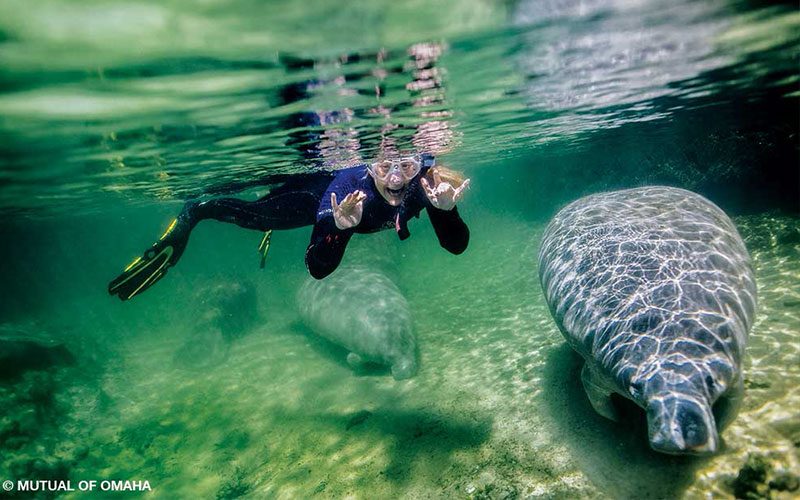Hometown: Pierre, S.D.
Years Diving: 10
Favorite Dive Destination: Ningaloo Reef, Western Australia
Why I’m a DAN Member: Because accidents happen, and it’s good to know you have that extra protection just in case.
Scubapro Deep Elite Ambassador and Wyland Foundation Ambassador for the Planet Stephanie Arne has the distinction of being the first female host of Mutual of Omaha’s Wild Kingdom. She considers diving a big part of how she came to have the job. Arne’s giant stride into the underwater world took place at Looe Key, Fla., in 2006 — only one year after she first set eyes on the ocean.
How has diving changed your life and career path?
Diving is a huge part of my life. I love working in the ocean, showing people amazing marine life and helping them learn how they can protect it and be more connected to it.
I always knew I wanted to be a wildlife educator, but I didn’t know exactly where I would find my place. I’ve worked with zookeepers, animals, conservationists, ecologists, trainers and rescuers and loved it all. I also loved teaching at the zoo and in the classroom. In diving I found a perfect opportunity to educate, and I went to work as a dive guide and whale-shark spotter in Australia.

Doing educational presentations on the boats was different because I could teach people about wildlife and then say, “OK, now let’s jump in and go see everything I just told you about.” I’m always thrilled to see people experience the feeling they inevitably get when the mysteries of the ocean world are unveiled to them. I just love watching people reach the surface and say, “I get it — I see what you were talking about — everything on the reef is connected, and now I understand how it’s like that on land, too.” [Stephanie breaks into a Disney song:] I can show you the world — I wanted to be people’s Aladdin!
You were in your mid-20s at the time. It was just the beginning for you.
Yeah! After Australia I went to the Honolulu Zoo Society. Even though I was working with land animals again, I was on an island and still involved with the ocean. I collaborated with Sustainable Coastlines Hawaii, the National Oceanic and Atmospheric Administration (NOAA), the Hawaiian Islands Humpback Whale National Marine Sanctuary and the Hawaii Invasive Species Council. I began doing educational videos for the zoo and became a regular on the local news channels. Then Mutual of Omaha had a contest to find the next host of Wild Kingdom, and boom! When I won, I had the mind-blowing realization that I likely wouldn’t have gotten the job if it weren’t for diving. The diving was critical for developing the experience and credibility that helped me land the job. And now, instead of being limited to the people in front of me on the boat or in the zoo, I can share messages about wildlife and conservation with countless people around the world.

So what’s next?
I started a company called the Creative Animal Inc. as a speaking platform to raise awareness about the interconnectedness of everything. Recently our team started a nonprofit outreach called the Creative Animal Foundation to develop a curriculum to take to corporations and schools all around the United States. This nationwide tour will connect people to the planet, empowering them to engage their inner creative animals and find ways to live, work and play more sustainably.
Of course you see some really beautiful things while diving, but you also see the impact of pollution. What have you seen that has affected you the most?
Ugh. The trash. It’s so bad. And most of it is plastic, which never disappears. It just breaks up into smaller and smaller pieces. Animals throughout the food chain ingest it and absorb the toxins. Take tuna, for example. Tuna are large predators that eat smaller fish, which are full of these chemicals, and this concentrates the toxins as they move up the food chain. When we eat tuna, we are ingesting the toxins, too.

Then you see animals being strangled by or choking on trash. It’s heartwrenching to see an animal struggling with something that could very well have been yours. Witnessing these things really resonated with me, and that’s why I’m so incredibly determined to teach people about plastics and the ocean. Why, for example, are we even using straws?
I think the key is to learn about how truly connected we all are — to the food web that sustains us and to that plastic. It doesn’t just affect wildlife, it ultimately affects humans as well because everything is connected. I think that’s the most important thing I can teach.
Explore More
Watch Stephanie Arne in “Mission Manatee,” an episode of Mutual of Omaha’s Wild Kingdom.
© Alert Diver — Q2 Spring 2016